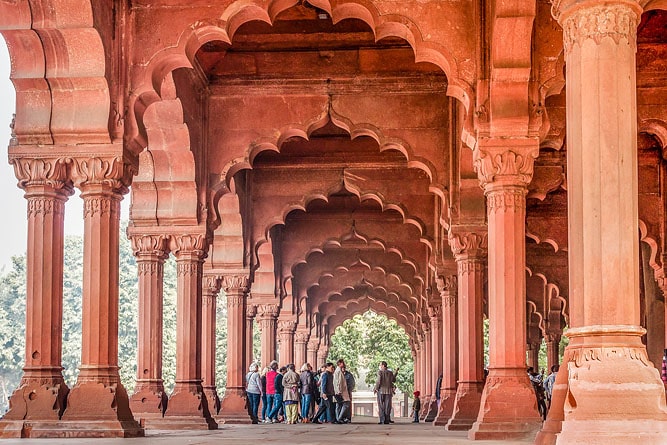Red Fort (Lal Qila)
Historical monument in Delhi
should-see attraction
Opening hours: dawn-dusk Tuesday-Sunday (closed on Monday)
Address: Netaji Subhash Marg, Lal Qila, Chandni Chowk, Delhi
Ticket price: Indian/foreigner ₹50/600, audio guide in Hindi/English ₹69/118
Visit duration: People typically spend 1 to 2 hours here
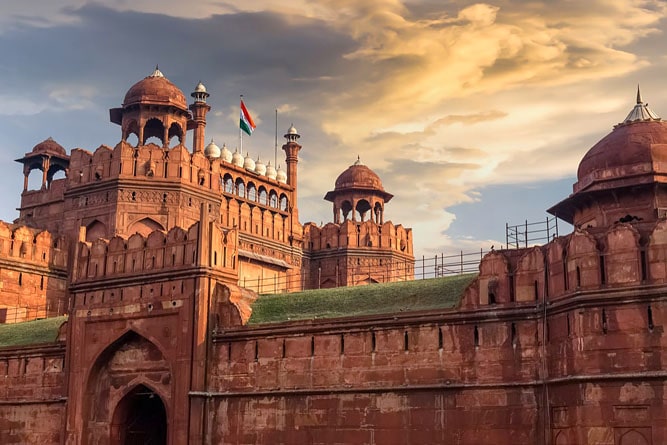
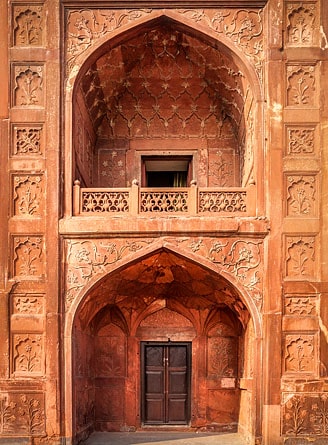
About Red Fort, Delhi
The Red Fort, also known as the Lal Quila, is located in Old Delhi. The fort is the only Mughal Architecture that achieved its honorific from its prime element, the red sandstones. It was the second home for the Mughal rulers, situated on the bank of the river Yamuna.
The fort not only witnessed the decline of the Mughal Empire but also had to witness and chronicle the struggles and sufferings of numerous Indian freedom fighters during the rule of the East India Company. The fort signifies the dream of every Indian when the tricolour is hoisted on its front gate. The Red Fort proudly presents Independent India.
UNESCO announced the Red Fort as a world heritage site.
History of Red Fort
The Red Fort was built by Shah Jahan. The construction began on the holy Islamic month of Muharram which in the Gregorian calendar was May of 1638. Ustad Ahmad Lahori was the chief architect of the complex.
The fort was constructed for the Mughal Emperors when emperor Shah Jahan shifted the empire’s capital to Delhi. The emperor supervised the construction. It took 10 years to complete the fort.
In the mid-18th century, the silver ceiling of the Diwan-i-Khas was melted by the Marathas to strengthen their defence. The fort was pillaged by Nadir Shah in the mid-18th century. Most of the crown jewels including the Peacock Throne were taken during the invasion.
The fort was demolished up to 80% during the Imperial rule in India.
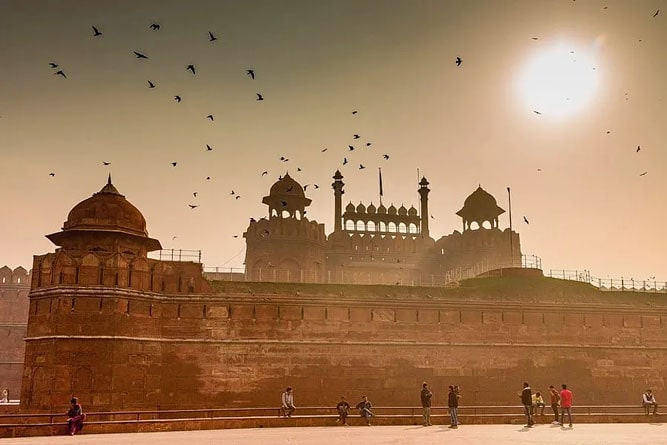
Architecture of Red Fort
The Red Fort marks the pinnacle of Mughal architecture. The structure of the fort is the outcome of the synthesis of the Persian palace with Indic and Timurid architecture. The entire construction of the fort is carved from red sandstones and white marble.
The Red Fort occupies 255 acres of land that is fenced by 2.4 km of a defensive wall. The height of the walls changes from 59 feet on the moats to 108 feet on the ground. The walls are interrupted by bastions and turrets.
The octagonal structure of the fort with marble furnishing and double dome surpasses the prior Mughal architectures in magnificence. The east-west axis of the fort is shorter than the north-south axis. The fort echoes the enriched Shahjahan style through its artwork, colour and structural design. The artwork of Zer-jharokha can also be observed at the Red Fort.
The three gateways of the Red Fort are the Lahori gate, Delhi gate and Khizrabad gate. The complex consists of several historic structures that retain some of the lost elegance despite the damage inflicted on them.
The main gateway is positioned to the east, in the direction of Lahore, and thus became recognised as the Lahori Gate. The structure was modified by adding a barbican during Aurangzeb’s rule. With a similar appearance to the main gateway is the Delhi Gate situated in the south. Two life-size elephant sculptures are settled on either side of the gate, facing each other.
Beyond the Lahori gate lies a courtyard known as the Chatta Chowk or Bazaar-i-Musaqqaf. The structure of the market resembles a vaulted arcade. It ends in the middle of the courtyard. It was a market for the royals during the Mughal rule.
The drum house or the waiting hall, popularly known as Naubat Khana is located on the east wall of the court. The central tank and the side arcades which once exited were demolished by the British after the Rebellion of 1857.
Naubat Khana leads to the central inner court. The court is enclosed by galleries. On the furthest corner lies the public audience hall or the Diwan-i-Aam. It was the official administration that dealt with the affairs of common citizens. The columns of the hall portray the exemplary craftsmanship of chunam stucco. The balconies are carved from marble stones.
At the northeast corner of the Red Fort, is a tower, Shahi Burj. The tower is used as a medium to draw water from the river Yamuna and fill the water canals, known as Nahr-i-Bihisht or the ‘stream of paradise’ running through the centre of the pavilions or the summer houses. The canals connect the pavilions.
The Mumtaz Mahal was the quarter for Shah Jahan's wife and the Rang Mahal was the summer house of the emperor’s wives and mistress. Both are located on the southernmost side of the Red Fort.
The canals cater to the central marble pool that is located between the two quarters. The Rang Mahal or the palace of colours is furnished with mosaic artwork on mirrors and painted with bright colours.
The living chamber of the emperor, the Khas Mahal is connected to the Muthamman Burj. It is an octagonal tower located by the riverbank. The quarter of the emperor was cooled by the water canals.
The Diwan-i-Khas is constructed with white marble stones and inlaid with precious stones. The peacock throne room was settled in this hall of private audience. The administrative dealt with royal affairs. The wooden ceiling is the restoration of the once-silver ceiling.
The Hammam, the imperial baths, was made of marble with three domed rooms and patterned floors. The rooms were separated by corridors. The baths were lit by a coloured glass skylight. There were three fountain basins in the eastern room. A marble reservoir can be located inside the bath.
The pearl mosque of the Moti Masjid is located west of the imperial baths. The mosque has three domes and a three-arched screen leading to a courtyard. It is created from white marble. The Red Fort Baoli or the step-well retained its unique originality of being two sets of staircases leading to the well.
The Hira Mahal, or the diamond palace built by Bahadur Shah II, is located at the southern edge of the fort. The Hayat Bakhsh Bagh is situated at the end of the diamond palace and the northeast part of the Red Fort. The garden consists of a reservoir that is dry at present.
A red stone Zafar Mahal is set in the middle of the reservoir. To the north lies the apartments of the imperial princes, or the Princes’ Quarter, which later was altered into a tea house by the British.
The Red Fort continued to be renovated till the last Mughal emperor, Bahadur Shah II. As the Mughal empire weakened, different rulers gained authority over the fort which resulted in the mutilation of the complex.
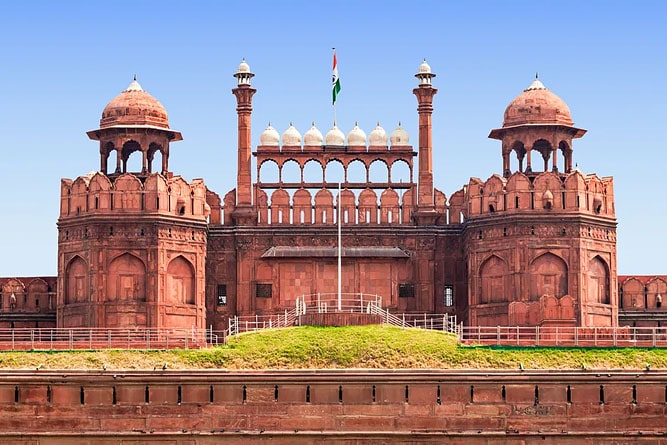
Entry fee and timings
The Red Fort is closed only on Mondays. The time for the fort is from 9:30 am to 4:30 pm. The entry fee for Indians is ₹35 and for foreigners is ₹500. For a video camera, you have to pay ₹25.
For the light and sound show, the price for adults is ₹80 on weekends and ₹60 on weekdays while for children it is ₹30 on weekends and ₹20 on weekdays.
The timing for the light and sound show varies with season.
- February to April: 8:30 pm to 9:30 pm (English), 7:00 pm to 8:00 pm (Hindi)
- May to August: 9:00 pm to 10:00 pm (English), 7:30 pm to 8:30 pm (Hindi)
- September to October: 8:30 pm to 9:30 pm (English), 7:00 pm to 8:00 pm (Hindi)
- November to January: 7:30 pm to 8:30 pm (English), 6:00 pm to 7:00 pm (Hindi)
Facts and tips about Red Fort
- The National Flag has been hoisted by the Prime Minister at the Lahori Gate on August 15 since 1947.
- The second floor of the Naubat Khana now houses the Indian War Memorial Museum. The archaeological museum is situated in the Mumtaz Mahal.
- The Red Fort hosts a Light and Sound show that chronicles the story from its inception during Shah Jahan's rule till the independence of India. It is an hour-long audiovisual show with speeches by Mahatma Gandhi, and Chandra Sekhar Azad and also the first speech by Jawaharlal Nehru as the Prime Minister of India. The show ends by playing the national anthem. A visit to the complex demands the show to be a must-watch for all tourists.
- The Red Fort offers official guides for tourists. The complex has plaques that serve the required information but if you want you can hire guides.
- With so many structures to visit in the complex, be prepared to walk and make sure to carry an umbrella, cap and water bottle to save yourself from the heat. Also, to avoid the crowd, try to reach the fort early.
How to reach Red Fort
Red Fort is situated in Delhi city centre and Jama Masjid is just nearby. The fort can be reached from Connaught Place in about 15 minutes by car. Humayun's Tomb is a 20-minute drive away. From Qutb Minar and the Lotus temple, it takes approximately 40 minutes by car to reach Red Fort.
See location on Google Maps
Other attractions near Red Fort
- Jama Masjid - 1.1 km
- Connaught Place - 4.4 km
- Humayun's Tomb - 7.5 km
- Lotus Temple - 15 km
- Qutb Minar - 19 km
FAQs about Red Fort
1. Is photography allowed in the Red Fort?
Yes, you can capture photos in the Red Fort.
2. Is there any good place to eat near the Red Fort?
Yes, you can find many good restaurants near the fort. But remember food is not allowed in the fort but water bottles are allowed.
3. Does the fort allow carrying bags?
Yes, you are allowed to carry small bags in the Red Fort.
4. Are there any good places to shop near the fort?
Yes, there is and among them, the Meena Bazaar has a great collection of things that are cheap and tax-free.
